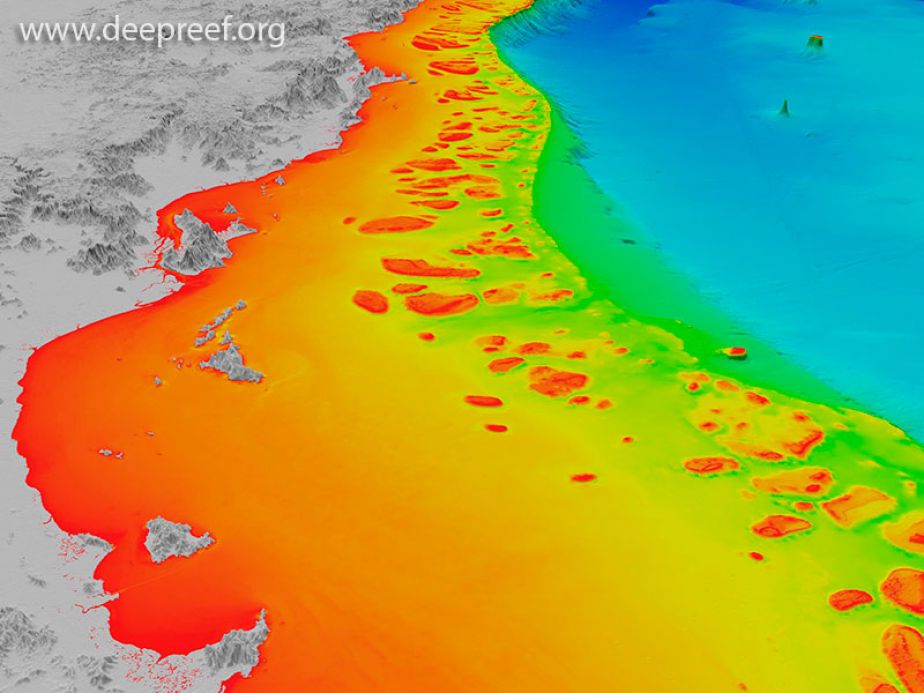From James Cook University by Robin Beaman
James Cook University is calling for volunteers to help map the seafloor around the Great Barrier Reef to better protect the natural icon.
BBC – Great Barrier Reef with David Attenborough (2016)
David Attenborough returns in this landmark series to his most magical place on earth exploring the Great Barrier Reef aboard the research vessel Alucia.
Part 1: Builders David descends beneath the waves at night in the state-of-the-art Triton submersible, the first of its kind to visit the reef.
He meets some of the tiny coral animals that built the reef and helped to turn it into an underwater wonderland.
He then takes to the skies to witness the vast scale of their endeavour, a living structure that provides a home for thousands of species.
Using cutting-edge technology to generate computer scans of the sea floor, David learns that the Great Barrier Reef we know today is much younger than scientists ever imagined.
He meets some of the people that have lived alongside it and who have told stories of its origins for thousands of years.
JCU marine geologist Dr Robin Beaman said the Royal Australian Navy does great work mapping the main shipping channels and hazards to navigation such as coral reefs, but there are still many areas that need to be mapped.
“Around 40% of the vast Great Barrier Reef shelf has been mapped with digital depth soundings using modern equipment, but there are some remote areas lacking any digital depth data,” he said.
Dr Beaman said there was an untapped resource that could be used to help fill the gap.
“Many vessels on the Reef use relatively sophisticated echo sounders, combined with GPS to measure the depth of water and conduct safe navigation. They give a good picture of the seafloor, but the problem is the data are not logged – it just appears in the moment and then is lost,” he said.
In 2018, together with underwater-film specialists Biopixel and their expedition vessel ARGO, the JCU team tested a SmartLog USB data logger, developed by TeamSurv in the UK.
Depth and GPS position data are downloaded through the SmartLog direct to a USB stick.
The Great Barrier Reef Foundation has provided $10,000 to the group to install loggers onto volunteer vessels.
“The SmartLog innovation will enable us to put many more sets of ‘eyes’ in the water to give scientists an accurate picture of the Reef right now and to help map areas of the Great Barrier Reef that we know very little about,” Great Barrier Reef Foundation Managing Director Anna Marsden said.
“It’s a unique opportunity for citizen scientists to easily capture and deliver valuable data to Reef scientists that can be used to inform restoration and adaptation efforts on the Reef.
“Ultimately the Reef will benefit from these types of innovations and the Great Barrier Reef Foundation, with support from our corporate partners, is pleased to be able to help elevate this project to the next level,” she said.
“We have partnered with the Great Barrier Reef Foundation to establish a pool of SmartLog USB data loggers in Cairns. The Citizens of the Great Barrier Reef are also involved, which gives people a role in contributing valuable citizen science data to improve a dataset that helps the Reef,” said Dr Beaman.
He said the group is mainly looking for expedition-style vessels that may travel multiple days to remote parts of the Reef, and that also have GPS navigation and echo sounder systems onboard.
“It’s a simple process to install the SmartLog and the ongoing maintenance just involves collection of the depth data off the USB stick,” he said.
A raft of detailed new bathymetry datasets
have recently been published on the AusSeabed Marine Discovery Portal.
Dr Beaman said the aim is to use the new depth data to improve the accuracy of the 3D depth model of the Great Barrier Reef.
“The shape of the underwater landscape, with its shallow and deeper reefs, pinnacles, holes and channels, influences the path of seawater carrying cooling waters, nutrients and sediment through the reef matrix.
“Detailed knowledge of the seafloor depth is critical for understanding the distribution of seabed habitats, to provide data for coastal inundation forecasting, flood plume modelling and crown-of-thorns starfish control efforts,” he said.
Dr Beaman said the 3D depth data will be also shared with the International Hydrographic Organization’s Data Centre for Digital Bathymetry and the Australian Hydrographic Office.
Volunteers can apply to be part of the project here
Links :
- Hakai Mag : Citizen Science Comes of Age
- Reef Life survey
- Spatial source : High resolution bathymetry data trove released
- GPS world : TCarta to map seafloor around remote Pacific island nation
- GeoGarage blog : Undersea maps reveal Great Barrier Reef in unparalleled detail / This fleet of underwater robots will help citizen ... / Why saving our blue planet may lie in the hands of citizen scientists / NOAA announces launch of crowdsourced ... / Diving enthusiasts could be used to measure ocean ... / Smartboard turns any surfer into an amateur ocean ... / Robot revolution: new generation of cheap drones to ... / Crowdsourcing ocean navigation data / The oceans are in the Cloud / Unlocking the Ocean : smart ocean planning using ... / Beyond charting : nautical information for the 21st ... / Beta test of crowdsourced bathymetry holds promise ... / Beyond charting : nautical information for the 21st ... / Ocean floor to be mapped by 2030 ?



EOS : Making the First National Seafloor Habitat Map
ReplyDelete